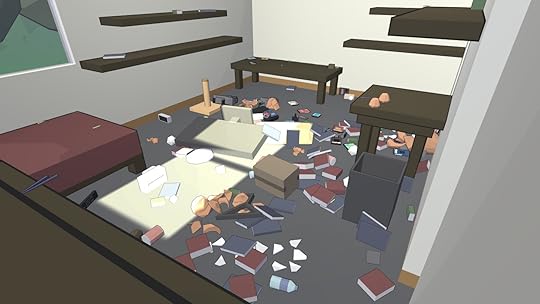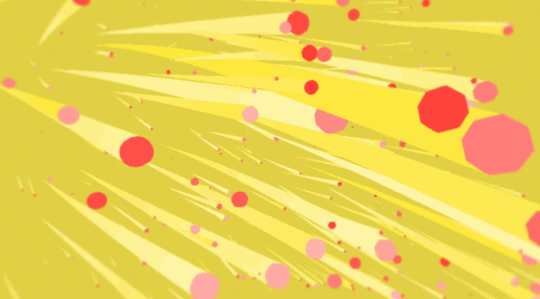Kill Screen Magazine's Blog, page 269
May 21, 2015
Sunset is a game of small details and uneasy questions
Is art beholden to aesthetic or culture? You decide.
Catlateral Damage reminds me why I'm a dog person
You are a cat. Your owner has left you home alone as they do every day. Your window has opened, and it is time to punish your unwitting human the only way you know how: mass destruction. Such is the premise of Catlateral Damage, a first-person cat simulator by developer Chris Chung. Similar to Katamari Damacy, you are in a space with a limited amount of time to do a lot of damage—but instead of playing an adorable alien prince rolling up items, you’re an adorable cat with a predilection for carnage.
we are truly at their mercy
Catlateral Damage, conceived at the 7DFPS game jam in 2013, was inspired by Chung’s childhood cat, Nippy, who he describes as the epitome of the aloof and ruinous cat. It was greenlit for Steam and Kickstarted in 2014, and the full game is finally being released next week. As a cat you roam your empty house, leaping onto countertops and racing the clock to push off as many valuables as possible. The rooms in the house are procedurally generated to maximize unique demolition possibilities. The game has collectibles and unlockable cats, so if the standard playable cat doesn’t look enough like the destructive feline in your life you can unlock one more like your little hellion.
The videogame community is clearly overrun with cat people. There are countless games about cats, even games for cats. Like Catlateral Damage, My Garbage Cat Wakes Me Up at 3 AM Every Day documents the supreme douchiness of cats—and the suckers who for some reason willingly put up with them. Neko Atsume, the Japanese cat game so adorable that people have ignored its language barrier for the sake of the cats, has been the obsession of many. I admit that, despite being a fervent dog lover, I am not immune: my kitten has her own special games installed on my iPad in a folder all for her.

The fact that Catlateral Damage glorifies the horribleness of cats shows that we are truly at their mercy, that the parts we love most about them are the parts that are their most psychopathic. When my kitten looks me dead in the eyes as she pushes a glass off the windowsill, she’s letting me know who is truly in power. This is the reminder in Catlateral Damage: we are not the masters of our homes, but rather the willing hostages of our feline overlords.
Life is Strange's second episode is best when it stands still
Life and death and the poignant joy of having absolutely nothing to do
May 20, 2015
This crab-shaped controller will make you hungry for more anthropomorphic handsets
You’ve got crabs, videogame lover—a crab simulator and crab-shaped controller, that is.
The controller was created by John Choi, a student in Carnegie Mellon University’s Interactive Art and Computational Design Program. It consists of an orange body with four articulated crab legs. Unlike the real creature, Choi’s crab does not have claws and can therefore be manipulated without risking the user’s health. Those claws do, however, exist in Choi’s crab simulator, a game in which the crab’s legs are manipulated by adjusting its doppelganger of a controller.
Choi’s crab is an anthropomorphic handset. Since it resembles the character it is meant to control, its functionality is readily apparent: move a physical crab leg and watch the same thing take place in the virtual world. While one cannot reasonably expect every handset to resemble the character it controls—you would need hundreds of controllers-cum-voodoo-dolls to play Madden—the logic and appeal of this idea is readily apparent.
Choi's crab is an anthropomorphic handset.
The crab controller is not an endangered species. Choi has released the files needed to create the plastic crustacean using a 3D printer. He also purports to have entered his creation in a variety of 3D-printing contests in the hopes of winning a 3D printer to donate to a middle school or high school. For the first time ever, then, crab may be the (intellectual) food of the people.
You can find out more about the crab controller and create your own by checking out this page.
Get mind-blasted by the twirling interactive art of Iridescent Configurations
Your mind probably exploded the first time you discovered the iTunes visualizer. Hopefully, you were alone, unsuspecting, and casually perusing your library on an uneventful night. Then, one accidental keyboard press later—BOOM. There you are, with a Pink Floyd light show on command at the tips of your fingers, allowing you to make the lights implode, divide, rejoin—all with the flick of your wrist.
According to creator Oliver Garcia-Borg, Iridescent Configuration was "designed to give an unusual sense of agency," allowing players to influence the strange behaviors of eight different "experiments in motion, interaction, colors, shapes, and nonsense." he interactions feel like vignettes into artistic control. Each configuration (which can be shifted with the number buttons on your keyboard) drops you into a scene with varying degrees of interactivity, where you can twirl and twist iconographic symbols of modern art. Most of the materials are vibrant, yet sparse, each with its own version of geometric simplicity.
vignettes into artistic control
Though the itch.io download page describes Iridescent Configuration as, not a game, but a "clusterfuck," the variations in agency seem part of a larger question on how much control a user needs for a sense of play. Of course, having complete control over a beautiful light show or an iridescent shape feels naturally enticing. One of the scenes even gives you swarm-like control over a bunch of blue paint blobs, their sudden turns appearing like an attack formation you direct. But there's something to be said for the more subtly swayed configurations, too, like number six, which spins like a great big sun getting pushed and pulled ever so slightly by a gravitational pull.
Not to mention that its hard to think of these configurations as "clusterfucks" (again, creator's description) since each stands very much independent of the others. Though most of the configurations sustain that modern art theme, the final one left me scratching my head before finally emitting a soft and revelatory "ohhhhh."
After controlling the abstract visuals of every other configuration, the last one brings you to a very familiar scene, with a tree and a bunch of birds perching on it. Eventually, the birds start dying off, and there's nothing you can do about it. One by one, they up and expire, falling from the tree and rolling away off-screen. It's funny, but also makes you feel kind of helpless to do anything. After the power trips of the other configuration, it leaves a more level-headed impression than any session with an iTunes visualizer might.
You can play Iridescent Configuration for free on PC, Mac, and Linux. Also check out the creator's other work, Oliver Garcia-Borg, on his website.
May 11, 2015
The game-like films of David Lynch
To engage with David Lynch films is to undertake a puzzle.
May 8, 2015
The conference schedule for Two5six is available now
Two5six, our annual conference and festival, is a three-day celebration of a life well-played. If you haven’t been to Two5six before, you still have several days to buy a ticket for our conference and other events. The final schedule is now available for our conference next Saturday, May 16th. You can view the full festival schedule on Two5six’s website.
Saturday’s conference will bring together leaders from game design and other industries to discuss the connections between games and other creative spaces. Game designers David O’Reilly (Mountain), Kara Stone (Sext Adventure), and Torfi Frans Olafsson (Eve Universe) will share the stage with culture-shapers like Randy Hunt (Creative director at Etsy) and Christian Rudder (Founder of OKCupid) to find the common threads between them. Our keynote speakers, Amy & Ryan Green, are creating That Dragon, Cancer, a game about processing their son Joel’s terminal cancer. An excerpt of a documentary about the Greens and the development of their game will be screened Friday night at the Two5six film fest.
10:00-10:15
Opening, Jamin Warren
10:15-10:50
‘Craft’, Randy Hunt & Katherine Bidwell
10:50-11:25
‘Spectatorship’, Marcus Reed & John White
11:40-12:15
‘Intimacy’, Christian Rudder & Kara Stone
12:15-1:00
Keynote, Amy Green & Ryan Green
2:30-3:05
‘Sound to Story’, David O’Reilly & Bianca Giaever
3:05-3:40
‘The Infant Mind’, Youngna Park & Willow Mellbratt
4:00-4:35
‘Space’, Torfi Olafsson & Lucianne Walcowicz
Two5six’s three-day festival will also feature an film fest the evening of Friday, May 15th, and our arcade of curated games Sunday, May 17th. All events will take place at Villain (50 North 3rd Street) in Williamsburg, Brooklyn.
A game based on Mr. Chekov's writing rule turns everything into a murder mystery
A hanging gun must be fired.
Recreate Jamiroquai's "Virtual Insanity" music video in this game
I remember being eight-years-old and having a playground debate as to how Jamiroquai's music video to the song "Virtual Insanity" was made. We were kids, so obviously one of the suggestions was that it was magic. Another said it was computer graphics. But the most plausible was that the floors were moving. When bringing this suggestion to my dad even he agreed that it was probably the answer. It wasn't.
It's the dance of a cyborg.
If you're not familiar with the 1996 pop-soul record or its video, you should remedy that right now. Jay Kay, the band's singer, seems to glide across the grey floor of the set as he sings and dances. Sometimes he moves while stood completely still. This is the trick that had my school friends and I so fascinated. It's as if he's found a way to outdo Michael Jackson's moonwalk, which is itself a sort of illusion performed by gliding the feet in a certain way so that it appears as a backwards walking motion—in practice, it is. Here, though, Jay Kay isn't moving his feet at all, yet he moves across the floor. How?

The answer is simple. And it's not one of Jay Kay's admittedly skillful dance moves; no one can do the impossible. Nor is it a computer trick. If it were, that would prove rather ironic considering that the song is about the potential harmful effects of our obsession with technology (and that's back in 1996!). As revealed in an interview with the video's director Jonathan Glazer, the whole set was a self-contained unit on wheels that was built on a floor with no detail. The camera was attached to one of the walls so that when the set was moved around it would appear that only the objects inside the set, and that were separate from it, were moving—that included Jay Kay and the black sofas.
The method itself is very practical then. It would no doubt be solved easily these days with modern computer technology. But what would be lost in such a case would be the performance in front of the camera. What makes the "Virtual Insanity" music video impressive even today is its choreography, and not its practical effects, although they are all part of it. The way that Jay Kay tip-toes down a closing aisle between wall and sofa; how he steps at the same pace as the set so it appears that he's moving nowhere; and how he rises from sitting to standing while narrowly avoiding a collision with the wall. It all gives the impression that Jay Kay has a mechanical prowess. He's beyond mere dancing skill, his body always escaping being crushed or moving in inhuman ways as if he were assisted by cybernetic enhancements. It's the dance of a cyborg.
It is this that you must attempt to replicate in the videogame tribute to the music video. It's called, quite simply, Jamiroquai Game. You play as Jay Kay as he steps without moving on that grey floor. All the while, black sofas and chairs emerge out of the walls and glide across the floor. Your task is to ensure Jay Kay isn't hit by any of them. He must be as untouchable as he is in the video. If he isn't, a comical collision is had as his entire body ragdolls into a limp, jelly-like version of itself. It gets pretty tough, so if you're the kind of person to not give up on these challenges, you'll probably end up slipping into your own virtual insanity. Fitting.
Chroma Squad is fan service about fan service
Mighty Morphin Power Rangers meet Final Fantasy Tactics, with oozingly nostalgic results.
Kill Screen Magazine's Blog
- Kill Screen Magazine's profile
- 4 followers





